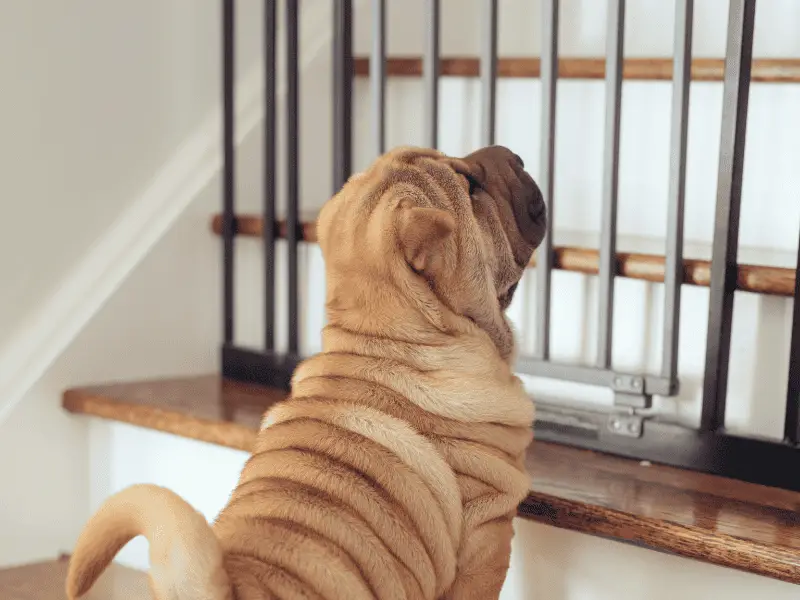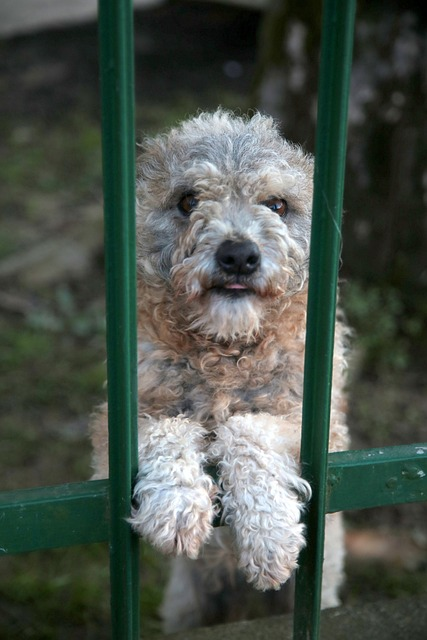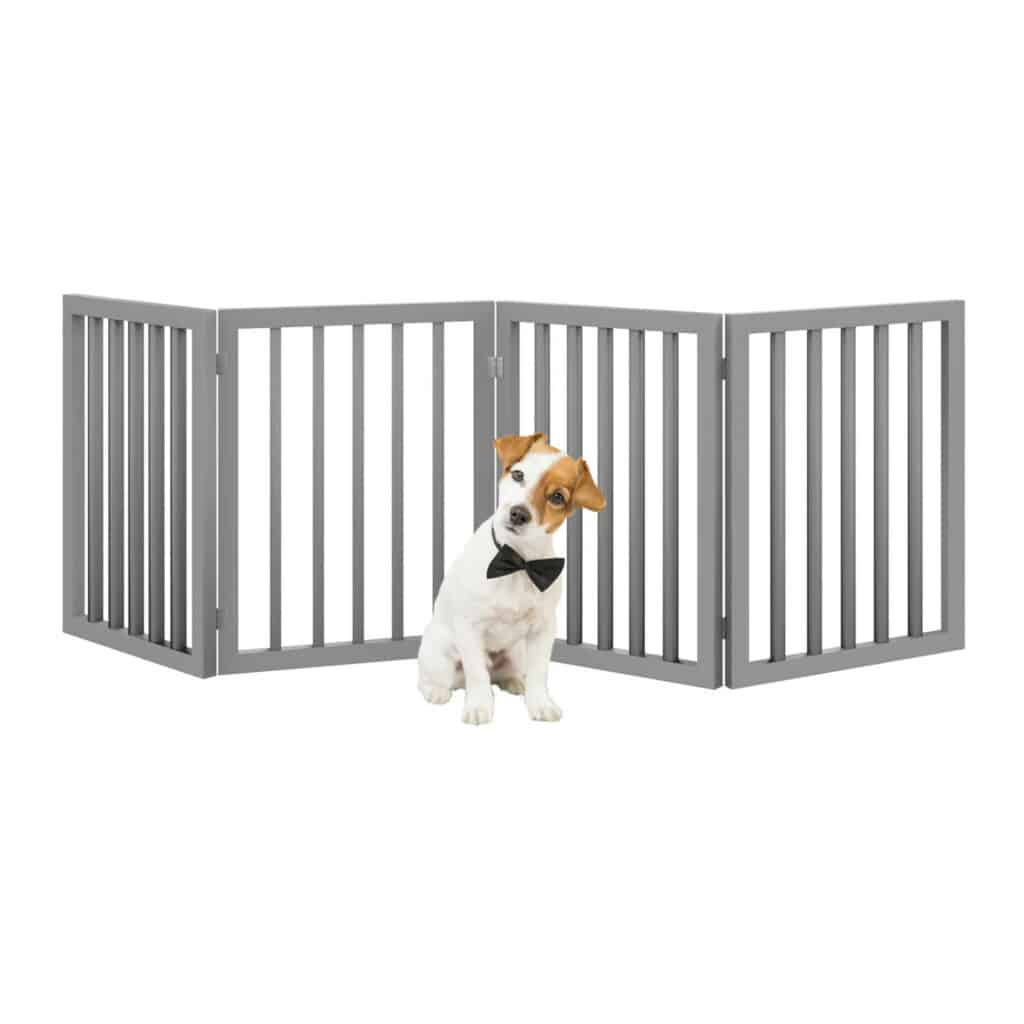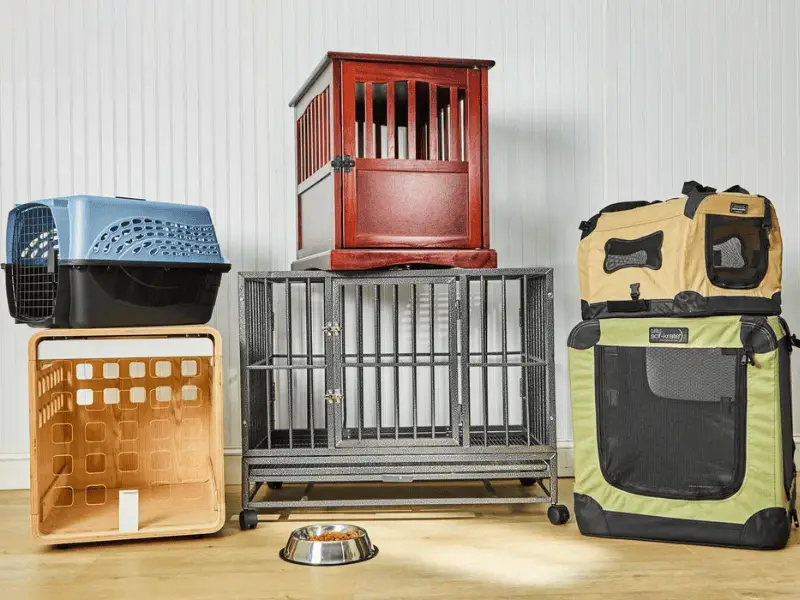The best dog gate not only helps keep your dog confined to designated areas but also provides a safe and comfortable environment for training. This comprehensive guide will explore the various types of dog gates available in the market, their features, their usage, and how to select the best one for your unique situation.

Types of Dog Gates
There are three main types of dog gates: pressure-mounted, hardware-mounted, and freestanding. Each type of gate has its advantages and disadvantages.
Pressure-Mounted Dog Gates
These gates rely on tension to stay in place between two walls or door frames, making them easy to install and remove without needing tools or drilling.
Pressure-mounted gates typically come in standard sizes that can be adjusted to fit various openings. They are not as sturdy as hardware-mounted gates and are not as secure as other types of gates.
These gates are a good option for temporary use. However, they may not be suitable for larger dogs or pups that are not strong enough to knock them over. They are the most affordable and easy-to-use type of gate, but they are not recommended for use at the top of the stairs.
Editor’s Choice – Quick Answer:
Best Pressure Mounted Dog Gates of 2023
North States MyPet Windsor Arch Petgate Overview
The gate can be used in a variety of settings, such as doorways, hallways, and stairways.
- Pressure or hardware-mounting options
- Triple-lock prevents pets from pushing
- Various sizes fit doorways
- Two extensions widen the gate
Dimensions:
- Width: 28.25 to 38.25 inches (adjustable with two included extensions)
- Height: 28.5 inches
Material:
- Heavy-duty metal construction
- Exclusive matte bronze finish for exceptional richness, durability, and depth of color
Durability and Features:
- Sturdy and built to last
- Triple-locking system for added security
- Pressure mounted gate, easy to install without additional hardware or tools
- Swings open both ways for convenience
Hardware-Mounted Dog Gates
Hardware-mounted gates are more secure than pressure-mounted gates. They are installed with screws or bolts and can be used in a variety of places. Hardware-mounted gates are a good option for dogs that are strong enough to knock over pressure-mounted gates.

These gates provide a more permanent and sturdy barrier, as they are securely mounted to walls or door frames using screws or brackets. They are ideal for larger dogs, high-traffic areas, and uneven or angled openings.
Hardware-mounted gates typically come in a greater variety of sizes and materials to match your home’s decor. Installation requires more effort than pressure-mounting but provides greater safety.
Editor’s Choice – Quick Answer:
Best Hardware Mounted Dog Gates of 2023
Extra Wide 30″ Tall Adjustable Auto Close and Open Gate with Swing Door For Doorway Stairs, 30″-80″
Durable, adjustable, versatile, and easy-to-use hardware-mounted dog gate.
- Extra wide to accommodate all pets
- Adjustable width to fits any opening
- Secure design with auto close to prevent pets from pushing through and escaping
- Swing door for easy pass-through
Dimensions:
- 30″ to 80″ wide, suitable for stairs, doorways, and large openings
- Stands 30″ tall
Material:
- Heavy-duty metal construction
- Exclusive matte bronze finish for exceptional richness, durability, and depth of color
Durability and Features:
- 80-inch extra-wide gate suitable for various spaces and openings
- Double-lock system for extra safety
- Mounts to straight and angled walls
- Bars are 2.2″ wide apart
- Walk-through opening width is 16.5″
- Hardware mounted for added security and protection
Freestanding Dog Gates
Self-supporting and portable, these gates can be easily moved or repositioned. They are suitable for open floor plans, wide doorways, and creating temporary barriers.
A free standing gate does not require any installation. They stand on their own and can be moved around easily. Freestanding gates are a good option for temporary use or for small spaces.
Freestanding dog gates do not require any installation or mounting hardware; they can fold and stand on their own using hinges or weighted bases to keep them upright.
These types of gates offer flexibility since they can be moved from one location to another without much effort once folded up flat.
Editor’s Choice – Quick Answer:
Best Freestanding Dog Gates of 2023
Freestanding Dog Gate for Doorways, Stairs or House
Set up dog-free zones in a variety of locations without installation.
- Portable, move anywhere
- No install, quick and easy to use
- Durable to withstand wear of active dogs
- Secure, prevents dog escape.
Dimensions:
- 73″ L x 0.75″ W x 23.75″ H (when set up)
- Ideal for openings 45″-60″ wide
Material:
- Made of MDF (Medium Density Fiberboard) and plastic
Durability and Features:
- No installation is required, avoiding potential damage to your home
- Suitable for blocking off doorways, hallways, and stairs
Core Dog Gate Functionality
In addition to the three main gate types noted above, there are several other types that every dog owner should be aware of. Here is a list of the eleven most common types of dog gates, listed in alphabetical order:
-
Customizable Dog Gates:
Tailored to fit specific dimensions, styles, or preferences, these made-to-order gates allow for personalized designs or unique features. -
Extra-Wide Dog Gates:
Ideal for wider openings, these gates can extend to accommodate larger doorways or spaces and often come with extension panels. -
Outdoor Dog Gates:
Designed for outdoor use in yards, patios, or decks, these gates are made from weather-resistant materials to withstand outdoor elements. -
Retractable Dog Gates:
Featuring a retractable mesh or fabric panel, these gates can be extended or retracted horizontally for temporary access restriction and easy storage when not in use. -
Step-Over Dog Gates:
Low in height and designed for small dogs, these gates provide a minimal barrier that can be stepped over easily, confining dogs to specific areas without completely blocking them off. -
Swing-Through Dog Gates:
With a hinged panel that swings open like a door, these swinging door options allow easy access for humans while keeping dogs contained, making them practical for areas requiring frequent passage. -
Travel Dog Gates:
Lightweight and portable, these gates are intended for temporary use during trips or visits to unfamiliar places, providing a secure barrier for your pup on the go. -
Walk-Through Dog Gates:
Featuring a built-in door or gate with a latch or lock, these gates provide convenient human access while keeping dogs contained.
We believe you do not have to sacrifice your home’s style and elegance to enjoy the rewards of having a dog. We’ve hand-picked these well-designed gates for your home.
13 Things to Think About When Buying a Dog Gate
1. Dog Height
When selecting the appropriate height for a gate, it’s crucial to consider your dog’s size and jumping ability. Choose a high enough gate that your dog cannot jump over it.
Most standard dog gates range from 30 to 36 inches in height, but taller models are available. Your dog’s size and breed should determine the gate height you choose. You may need to choose a taller gate if you have a large dog or a jumper dog.
As a general rule of thumb, the height of the gate should be at least 1.5 times taller than your dog’s shoulder height, ensuring that it cannot easily jump over it. For example, if your dog’s shoulder height is 24 inches, you should opt for a gate at least 36 inches tall.
However, some agile and high-jumping breeds, such as Border Collies or Belgian Malinois, may require even taller gates.
Extra Tall Dog Gate
An extra-tall dog gate is taller than standard dog gates. Extra tall dog gates are typically 38 inches or taller and are designed to keep large dogs or dogs that like to jump from getting into areas of the house that they should not be in.
2. Dog Weight
Dog weight is important when buying because it affects the strength and durability of the gate. Dogs tend to lean on or jump on the pet gate, so you want a gate that is not strong enough to withstand your dog’s weight, or the gate could collapse, injuring your pup or allowing them to escape.
Here are some tips for choosing a pet gate that is the right weight:
Consider your dog’s size and breed. Larger dogs and dogs with strong muscles require a stronger gate than smaller dogs or dogs with weaker muscles. Even a very active medium-sized dog or smaller dog that continuously jumps into a gate can create enough tension that the gate shifts.
3. Dog Width
Pet gates come in a wide range of widths, spanning from 20 inches to 36 inches. When selecting a gate, it’s crucial to consider your dog’s current size and potential growth. If you have a puppy, consider the estimated adult size to ensure the gate remains suitable and effective as your pet matures.
For larger breeds or dogs with wider shoulders, opting for a gate with a wider pass-through area or a small pet door can provide enough space to move through the gate entrance without feeling restricted.
Remember that gates come in various adjustable widths, so selecting one that can cater to your specific requirements will ensure your pet’s safe and comfortable environment.
Don’t just guess! Measure your dog’s width to get an accurate measurement. Use the measurement to choose a pet gate that is wide enough for your pup to pass through comfortably.
Seven steps on how to measure your dog’s width:
-
Stand your dog up straight.
-
Place the measuring tape at the widest part of your dog’s chest, just behind its front legs.
-
Pull the measuring tape snug but not tight.
-
Read the measurement on the measuring tape.
-
Add a few inches to this measurement to allow for a comfortable fit.
-
Choose a gate at least as wide as the measurement you just took.
-
You may want to choose an even wider gate if you have a large dog.
This measurement will give you the chest width. You will need to choose a pet gate that is wider than this for your dog to be able to pass through it comfortably.
Ideally, look for a gate that is 25% larger than the maximum girth of the average width of your dog’s breed. For example, a German Shepherd has a chest size between 71 – 81cm, so look for a gate approximately 40 inches wide (81cm * 1.25% = 101.25cm or 39.82 inches).
If you have a mixed breed dog, consider what you believe to be the dominant breed trait in its mix to help you find a reasonable measure for the dog’s width or chest size.
Here are some additional tips for choosing a pet gate that is the right width:
-
Add a few inches to the measurement you took of your dog’s width to allow for some extra space.
-
Don’t base the gate size on your dog’s current size but base your needs on the size of your pooch when it is an adult
-
Find the maximum dog width or chest size for your dog’s breed from the AKC
4. Door Width
The average width of a dog gate is 24 inches. Measuring the width where you plan to install the gate is essential to ensure it fits securely. Considering these measurements, you can choose a pet gate that effectively keeps your pet safely contained within designated areas in your home.
Choose a gate that can accommodate the widest measurement, ensuring a secure fit. Choose a gate wide enough for your pup to pass through comfortably.
To properly measure the width of a door for installing a dog gate, follow these steps:
-
Gather the necessary tools: You will need a measuring tape or a ruler.
-
Open the door completely: Make sure the door is fully open and secured in that position.
-
Locate the inner edges of the door frame: Identify the inner edges where the gate will be installed. These are the points where the gate will be anchored.
-
Measure the width at the top, middle, and bottom: Using the measuring tape or ruler, measure the width of the door frame at the top, middle, and bottom. Ensure that you measure from the inner edge of the frame on one side to the inner edge on the opposite side.
-
Record the largest measurement: Take note of the largest width measurement among the top, middle, and bottom. This is important because door frames may sometimes have slight variations in width due to factors like settling or warping.
-
Consider gate adjustments: Check the product specifications or installation instructions to determine if it can accommodate adjustable widths. Some gates have extension panels or adjustable mechanisms that allow them to fit a range of widths.
-
Choose an appropriately sized pet gate: Based on your recorded measurement, select a gate that fits the width of your door frame or can be adjusted to fit it. Ensure the gate provides a secure and snug fit without any significant gaps your pup could squeeze through.
Remember to double-check the measurements and consult the specific instructions provided by the manufacturer of the pet gate you are using, as different gates may have slightly different installation requirements.
5. Doorway and Entryway Frame Types
Dog gates come in various sizes and styles to fit different doorways and needs. Some gates are designed for standard door frames, while others are designed for wider or narrower ones.
Standard door frames are typically 32 inches wide. The best dog gates for standard door frames are typically 32 inches wide.
Wider door frames are typically 36 inches wide. Gates designed for wider door frames will typically be 36 inches wide.
Narrower door frames are typically 28 inches wide. Gates designed for narrower door frames will typically be 28 inches wide.
Choose a gate that is the right size for your doorway
Choosing the appropriate gate size for your doorway is crucial. If the gate is too small, it won’t fit properly, while a gate that’s too large might not provide enough security, allowing your pup to push it open easily.
It’s essential to assess the durability of your doorway or entryway frame when selecting a gate. Doors and entryways can suffer damage over time due to friction and wear from the gate opening and closing repeatedly. Additionally, dogs leaning and jumping on the gate can pose challenges and cause wear and tear.

The material of the entry frame plays a significant role in its durability. For instance, steel entry frames are generally more durable than wood ones. If you have a large or strong dog, choosing a gate made from a sturdy material is important while also considering the strength of your doors and walls.
When installing any pet gate, select the right entry frame type and carefully consider the materials of your doors and walls. By understanding the benefits and limitations of each option, you can make an informed decision that prioritizes the safety and convenience of both your pets and your family.
6. Wall Types
-
Drywall: Drywall is a common wall material made of gypsum. It’s relatively easy to install a pet gate on drywall using either pressure or hardware-mounted gates. For hardware-mounted gates, use appropriate anchors to secure the gate properly.
-
Plaster: Plaster walls are made of gypsum, lime, or cement and are more solid than drywall. Installing a pet gate on plaster may require using wall anchors and longer screws to ensure stability.
-
Brick: Brick walls are sturdy and can support hardware-mounted dog gates. However, you’ll need to use masonry anchors and drill into the brick to install the gate securely.
7. Door and Wall Types
What type of door or wall do you have? Awareness of your door or wall type is essential before installing a pet gate to ensure maximum safety and convenience for both pets and their owners.
Besides the standard doorway and entryways in a home, there may be occasions when there is a need to use a dog gate in a non-standard doorway so that you can have continuous temperature and airflow control.
Sliding, French, or pocket doors are non-standard doors that often allow for natural light and airflow. Installing pet gates can allow pet owners to keep these doors open while preventing the dog from going outside or entering certain rooms.
Non-Standard Door Types
-
Sliding Doors: Sliding doors are typically made of glass or wood and unlike a swing door, they slide horizontally on a track. They are commonly used for patios and large openings. When installing, you’ll need to consider pet gates designed specifically for sliding doors or use a pressure-mounted gate with extensions to cover the opening.
-
Pocket Doors: Pocket doors are space-saving doors that slide into a compartment within the wall. They are generally made of wood. Installing a dog gate in a pocket door opening can be challenging, as it requires a pressure-mounted gate or a custom solution that doesn’t interfere with the door’s sliding mechanism.
-
French Doors: French doors have two doors that swing open from the center. They can be made from wood, metal, or glass. To install a dog gate in a French door opening, consider using a freestanding or pressure-mounted gate that spans the width of the opening.
Benefits and Limitations
When choosing an entry frame type for installing a pet gate, consider factors such as cost, durability, and ease of use:
-
Sliding doors offer saving space but may require a specific gate design or additional extensions.
-
Pocket doors are also space-saving, but installing pet gates without interfering with the door’s sliding mechanism can be challenging.
-
French doors are stylish but may require a wider gate to cover the opening.
8. Gate material
Some gates are made of plastic, while others are made of metal. Choose a gate made of a durable material that your dog will not damage.
Wooden frames:
Wooden frames are popular for dog gates because they are strong and durable. They can be painted or stained to match the décor of your home.
Metal frames:
Metal frames are another popular choice for dog gates because they are strong and durable. They are also more resistant to damage from chewing and scratching than wooden frames.
Plastic frames:
Plastic frames are a less expensive option than wooden or metal frames. They are also lighter and easier to install. However, they are not as strong or durable as wooden or metal frames.
Woven wire frames:
Woven wire frames are a good option for dog gates if you need to allow your pup to see through the gate. They are also a good option for gates that will be used outdoors, as they are resistant to the elements.
9. Locks and Latches
Dog gates are a great way to keep your dog safe and secure, but they can only do their job if properly latched. There are various dog gate locks and latches available on the market, each with its pros and cons.
Types of Dog Gate Locks and Latches
-
Magnetic latches are a popular option for dog gates. They are easy to install and use, and they are relatively inexpensive. However, they can be easily opened by small children or curious dogs.
-
Barrel latches are another popular option for dog gates. They are more secure than magnetic latches but can be more difficult to install.
-
Sliding latches are a good option for dog gates that are used frequently. They are easy to open and close, and they are relatively secure.
-
Combination locks are a good option for dog gates that need to be extra secure. They are more difficult to open than other types of locks and can be a good deterrent for thieves.
Choosing the Right Dog Gate Locks and Latches
The best way to choose a lock or latch is to consider your specific safety needs. If you have a small child or a curious dog, you may want to choose a more secure lock. If you have a pet gate used in a high-traffic area, you may want to choose a lock that is easy to open and close.
No matter what type of dog gate lock or latch you choose, it is important to ensure it is installed properly. A poorly installed lock or latch can be a safety hazard.
Here are some tips for installing a lock or latch:
-
Make sure that the lock or latch is compatible with your pet gates.
-
Follow the manufacturer’s instructions carefully when installing the lock or latch.
-
Use the correct tools for the job.
-
Make sure that the lock or latch is secure.
By following these tips, you can help to ensure that your pet gates are properly closed and that your pup is safe and secure.
10. Purpose
It may seem obvious before buying any pet gates, but you should consider why you need one. Are you trying to keep your dog contained in a specific area? Or are you trying to prevent it from accessing certain spaces in your home? Once you can narrow your options, you are better positioned to know what type of gate to look for.
Reasons why you need a dog gate
Controlling access:
The best dog gates can help limit the dog or cat’s access to certain areas of the house, such as preventing them from entering rooms that may be off-limits or dangerous for them, such as kitchens or areas with delicate furniture.
Safety and confinement:
Dog gates can create a secure space for the dog, especially when the owner needs to keep them contained temporarily, such as during meal times or when guests arrive. This prevents the dog from running out of the house or the gate door and getting into areas that may cause damage or harm.
Separate spaces:
Dog gates can help create separate spaces within the home, allowing the dog to have their designated area while being visually connected to the rest of the household. This can be useful when the pet parents want to keep an eye on the dog but also wants to maintain some separation, such as during meal preparation or when working from home.
Training and behavior management:
Dog gates can assist in training and behavior management by creating boundaries and limiting the dog’s access to specific areas. It can aid in teaching the dog proper behavior and preventing them from engaging in undesirable behaviors, such as chewing on furniture or using other gates and going to places they shouldn’t.
The best gate type is versatile and used in various doors to provide safety, containment, training, and flexibility in managing the dog’s access and behavior within the home.
11. Place
Choosing the perfect spot to place pet gates can significantly impact the convenience and effectiveness of this essential pet accessory in your home.
The top pick best places to place a pet gate in your home are:
-
Stairways. Dog gates can be used to keep dogs from going up and down the stairs, which can help to prevent falls and injuries. However, the placement is important to prevent a trip hazard.
-
Doorways. Pet gates can block off doorways to rooms you do not want your dog to enter, such as the kitchen or the bathroom.
-
Living room. If you have a puppy or a dog still learning to potty, you can use a dog gate to keep them in the living room while you are not home. This will help to prevent accidents.
-
Kitchen. Dog gates can be used to keep dogs out of the kitchen while you are cooking. This will help prevent them from getting into food or burned by hot stoves or ovens.
-
Bathroom. Dog gates can be used to keep dogs out of the bathroom while you are taking a shower or using the toilet. This will help prevent them from getting into cleaning supplies or drinking from the toilet.
When choosing a place to put a dog gate, it is important to consider the layout of your home.
When we brought our German Shepherd puppy home, we wanted to install a gate separating the living room from other house areas.
However, the entryway between our media room (which we wanted to restrict access to) and the living area was too wide for any available dog gate on the market.
This setback was frustrating, but it prompted us to explore alternative locations for the gate that would still confine our puppy while allowing him the freedom to move within designated spaces.
We opted for two standard-sized doggy gates, one between the kitchen and one before the living room stairs. Although this solution necessitated extra creativity in space planning, we ultimately discovered that we didn’t need to place a barrier across the large entryway.
Five additional tips for placing The Best dog gates in your home
-
Ensure the gate is where your dog cannot easily jump over or squeeze underneath it.
-
Ensure the gate is not blocking a doorway or a hallway that you need to use regularly.
-
Decide if you want to place the gate in a location where your dog cannot see through it. This can help to prevent them from getting frustrated or anxious because they can see activity but can’t come to you.
-
Place the gate in locations that allow you to easily pass from one area to another without unnecessarily opening multiple gates.
-
Avoid placing gates in high-traffic areas of your home
These tips can help keep your dogs safe and out of dangerous areas.
12. Price
Prices of dog gates can range in price from around $28 for basic models to several hundred dollars for more luxurious or specialized options.
The average price of a dog gate is approximately $50. However, prices can reach $1400 or more, depending on the type of gate, the materials it is made from, and its features.
Some dog gates have additional features, such as a walk-through door, a locking mechanism, or a pet door. These features can add to the cost of the gate.
When choosing a dog gate, it is important to consider your needs and budget. If you are looking for an inexpensive gate that is easy to install, a pressure-mounted gate may be a good option.
High-end dog gates are the most expensive
When considering the price of high-end dog gates, it’s important to consider the premium materials, advanced functionality, and attention to detail that contribute to their higher cost. A high-end dog gate comes at a premium price. Here are some characteristics of high-end pet gates.
Material and Construction:
High-end dog gates often feature premium materials such as solid wood, metal alloys like stainless steel or brass, or high-quality, durable plastics. These materials add extra stability and enhance the pet gate’s strength, aesthetics, and longevity.
Customization and Design:
Some expensive dog gates may offer customization options to match the owner’s decor or specific requirements. This can include finishes, colors, patterns, or even personalized engravings.
The cost of getting a custom dog gate designed and installed can vary depending on several factors, including the size and complexity of the gate, the materials used, and the labor costs in your area. However, you can expect to pay anywhere from $200 to $500 or more to find gates that are customized.
Some luxury dog gates are handcrafted by skilled artisans, adding to their exclusivity and uniqueness. These pet gates also may have intricate designs, decorative accents, or fine detailing, contributing to their higher price tags.
Versatility and Adjustability:
Premium dog gates may have adjustable panels or extensions to fit a wide range of door or hallway widths. This flexibility allows them to be used in various locations, making them a more convenient gate option for pet owners.
Brand Reputation:
Established brands with a reputation for high-quality products and excellent customer service often have premium-priced dog gates. The brand name itself can contribute to the higher cost.
Additional Features:
High-end dog gates may include extra features like built-in pet doors, locking mechanisms, side panels, or advanced safety features to enhance functionality and extra security.
It’s important to note that the definition of “expensive” can vary depending on individual preferences, budgets, and market fluctuations.
13. Installation
When you’re ready to install dog gates in your home, choosing the right type of gate that fits your needs is essential.
Want to learn more about dog gate installation? Read our post about how to install the three main types of dog gates:
Pressure-mounted, hardware-mounted, and freestanding. Each type has its advantages and disadvantages.
Dog Gate Installation – Everything You Need To Know About How to Install a Dog Gate
Dog Gates Every Dog Owner Will Love
Are you a new dog owner or simply looking for ways to better manage your dog at home? One solution that may be worth considering is investing in dog gates.
We believe you do not have to sacrifice your home’s style and elegance in order to enjoy the rewards of having a dog.
Below are some dog gate options and five criteria to help you select.
Dog Gate Options: Dog gates you’ll love
We’ve hand-picked these well-designed dog gates for your home.
Often the below styles are available in other colors and/or sizes.
Dog gates not only help keep your pup safe and secure, but they can also make your life easier by creating designated spaces for your dog.
Even if you a new dog owner or simply looking for ways to manage your dog at home better, it may be worth considering is investing in a dog gate.
Criteria to help you select the best dog gates
Dog gates not only help keep your pup safe and secure, but they can also make your life easier by creating designated spaces for your dog.
Here are a few things to keep in mind when shopping for a dog gate:
-
Size: Measuring the width of the doorways or hallways where you plan to install the gate is important to ensure you purchase the correct size. Most gates come in standard sizes, but some can be adjusted to fit larger or smaller spaces.
-
Material: Dog gates can be made from wood, plastic, metal, or mesh. Each material has its benefits and drawbacks. For instance, wooden gates may look more stylish but may not hold up as well against a larger or more active dog.
-
Placement: Consider where you will be placing the gate. If you plan to use it at the top of a staircase, selecting a gate that can be securely mounted to the wall is important. A pressure-mounted gate may be sufficient if you plan to use it in a doorway.
-
Height: Make sure the gate you select is tall enough to prevent your dog from jumping over it. A good rule of thumb is choosing a gate that is at least as tall as your dog when standing upright on his hind legs.
-
Purpose: Think about why you need a dog gate. Are you trying to keep your dog contained in a specific area? Or are you trying to prevent him from accessing certain spaces in your home? Understanding your needs will help ensure you select the right gate for your situation.
Overall, dog gates can be a great investment for any dog owner. They provide peace of mind knowing your pup is safe and secure while providing structure and organization to your home. With the right gate, you can create a happy and harmonious living space for both you and your furry friend.





